Spring Field Semester 2024
Spring Field Semester 2024
Week 14 - Spring Field Semester 2024
by Christina
During the week of April 15-19, we took trips to Robinson Forest and Garrard County to assist with research projects and look for various species of wildlife. Dr. Cox, Dr. Price, Dr. Springer, Michael Ammerman, and Dr. McNeil all contributed their expertise to this week. Dr. Cox took us to Garrard County on Monday to show what species one might find in the palisades region of the Kentucky River, with the class looking for various amphibians, reptiles, and birds, as well as examining the tracks of various mammals. On Tuesday, we set up salamander board arrays with Dr. Price, and on Wednesday we used our chainsaw skills (gained earlier in the semester) to fell logs with Dr. Springer and Mr. Ammerman for habitat purposes. On Thursday we spent the morning learning to set up and use active mist-netting, as well as learning how to band and catalog migratory and non-migratory songbirds with Dr. McNeil. These activities gave us a wide range of experience with different wildlife, as well as teaching techniques used to survey those types of wildlife in relation to forestry. These activities provided us with a more holistic perspective of the forests that we’ve been learning about all semester, and exemplified the importance of wildlife within a well-managed forest. This week also taught us about the various ways that landowners might want to manage their land, which gives us a basis for understanding differing landowner requirements.
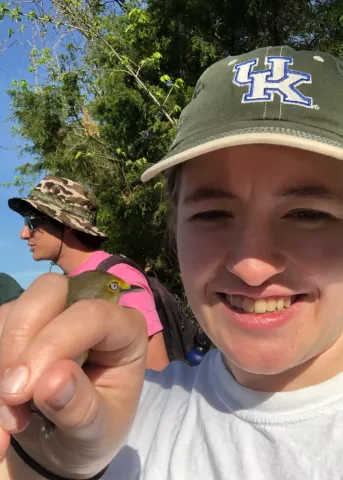
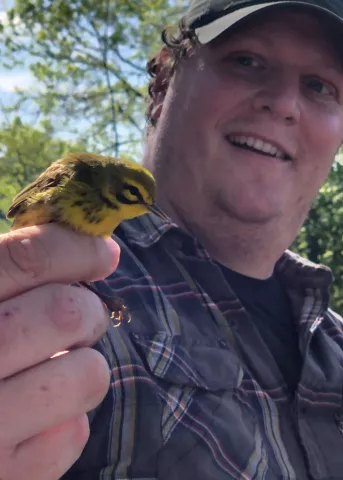
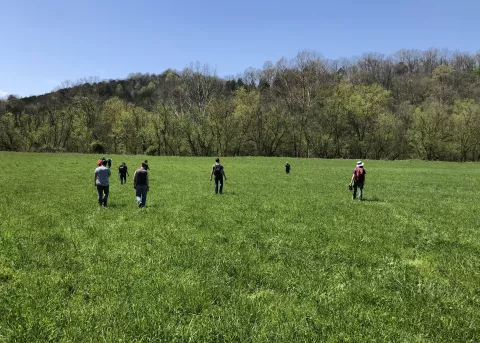
Week 13 - Spring Field Semester 2024
by Alex
For the second week of forest operations with Dr. Stringer and Mr. Ammerman, the class traveled to western Kentucky. Even though rain canceled all of the logging jobs that we were supposed to look at, we still saw the aftermath of a logging job on Tuesday at Pennyrile State Park. We met with two district rangers from the Kentucky Division of Forestry in charge of doing audits on logging jobs to ensure that the loggers are implementing best management practices properly. On Wednesday, the class then met with Mr. Soto from Soto Logging and John Williams a procurement forester. Mr. Soto showed off his impressive chainsaw skills by cutting down and bucking a few trees. We were also introduced to the rest of the Soto logging crew which was unique in the fact that they weren’t as large as other logging companies, but they use this to their advantage by targeting smaller logging jobs. By doing this, Soto Logging provide a great service to smaller landowners who still want to log on to their property. Then we went to see a stave mill and chipping mill that was in the process of being set up. After a night at Rough River State Park, we ended the week with a tour of Domtar Paper Mill and its massive complex.
These activities took the things we learned in the first week of forest operations and showed how the real-world application of these skills is used. We saw how KDF rangers assess logging jobs for the use of BMPs. Mr. Soto showed how the chainsaw skills we learned are used on standing trees. The stave mill and paper mill showed examples of wood product industries that are found across the state and how these facilities operate.
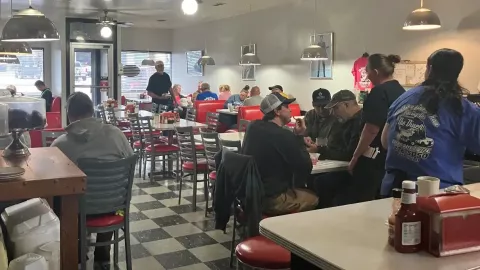
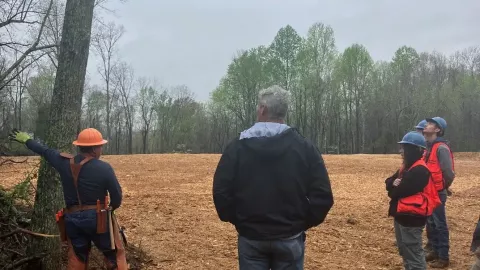
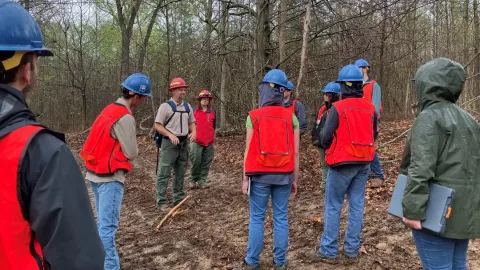
Week 12 - Spring Field Semester 2024
by Ben
This week was Forest Soils and Hydrology with Dr. Barton and was our final full week in Robinson Forest. We started the week by walking the watersheds of Robinson discussing the impacts that logging can have on stream health, understanding the differences between perennial, intermittent, and ephemeral streams, as well as taking some basic measurements. Understanding these fundamentals on loggings effects on stream health furthered our understanding on best management practices for Master Loggers which is something we learned about the previous week.
Day 2 was interesting as there was a threat of severe weather all day making our initial plans not feasible. Instead, we started the day by going up on to the fire tower and assessing the different soils of Robinson. This gave us a better understanding of forest soils which was valuable information not previously touched on in our soil science classes. We then went to an abandoned mine site and looked at polluted water and talked about how long it would take for this stream to heal which was a very bleak conversation. This conversation cemented in us how large of a role humans play in the natural world.
On our final day we assessed the stream ecology of 4 different sites with of various health and quality. We collected data on invertebrates and vertebrate populations using nets and salamander tallies. We also collected data on pH, temperature, and dissolved oxygen. This taught us what measurements hydrologists do in the field.
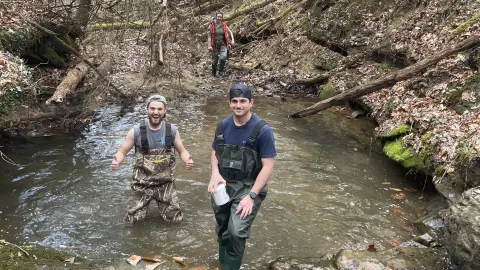
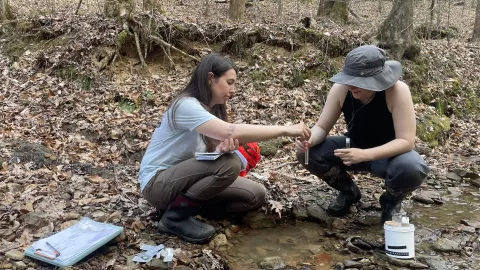
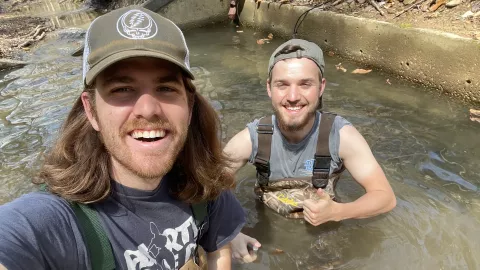
Week 11 - Spring Field Semester 2024
by Clay
We started with Dr. Cox and Dr. Springer on Monday morning helping Will, a graduate student, take measurements for his project at Griffith Woods Wildlife Management Area (WMA). Tuesday, we went to Clay WMA and spoke with the new manager as well as Jacob and Jimmie, some previous managers at Clay. Wednesday, we looked at telemetry at Robinson Forest with Nicole and Autumn, also graduate students at UK. Thursday, we were at Grayson Lake WMA and toured projects with Kevin and Josh, who work for Kentucky Department of Fish and Wildlife, including a visit to talk with Tim the logger they work with on those projects.
The project Will was working on was to track various effects on Kentucky Bluegrass Hardwoods. To track this, he was measuring their height, base diameter, diameter at breast height, and signs of browse. At Clay WMA, we looked at different management types on the forest like fire and herbicide effects on different types of habitats. Nicole and Autumn showed us how telemetry is used and how we find collars using this technology. Dr. Springer gave us a project to determine a way to track deer effects on Robinson Forest. Kevin and Josh took us to see the young forest stands and a timber cruise they would perform.
These activities were important for foresters to learn to understand their effect on wildlife habitat and how to asses the wildlife itself. This week really gave me an insight to habitat management and how I would track my habitats effectiveness.
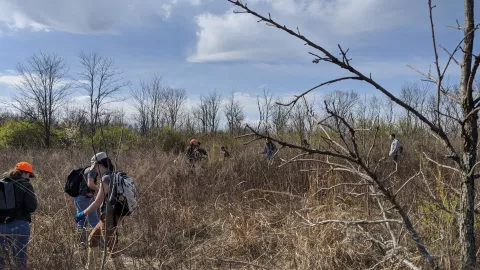

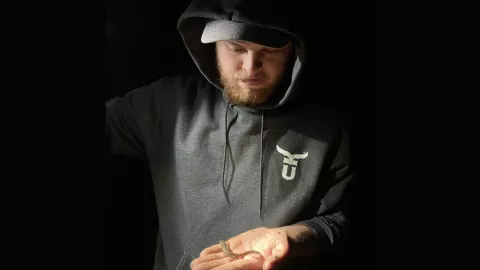
Week 10 - Spring Field Semester 2024
by Erin
We spent the first week back after spring break cruising the boardinghouse watershed with Dr. Muller in our final week of FOR 357 – forest measurements. There was a lot of hiking and measuring done as we traversed the watershed in groups of 4 and 5 to measure over 900 trees in 2 days. The first part of the class was spent gathering preliminary data with our groups so that we could determine how many plots we needed to take in order to get a statistically robust sample. During the rest of the week we measured tree height, diameter, and grade among other factors to get a holistic snapshot of the forest. Afterwards we compiled our data into reports for hypothetical landowners to be able to review information about their property.
These activities can seem fairly simple, but foresters use these skills all the time to cruise stands for timber volume when they’re working on timber sales. Graduating and being able to say that you have experience cruising is a great bonus to potential employers because it is such a fundamental skill as a forester that is used so frequently. Even as a wildlife biologist, being able to measure trees and tell how a stand is growing is an essential skill.
During the week we got to see interesting geologic formations in Robinson Forest, as well as the beginning of springtime flora and fauna. We were able to see spring beauties, trillium seedlings, succulents, and various species of salamander start to emerge from the streams near camp.

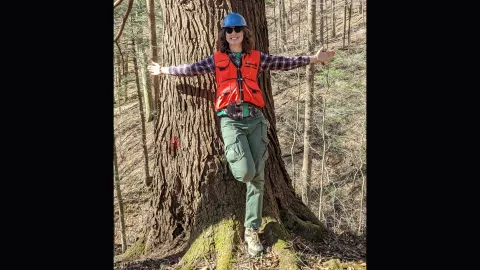

Week 9 - Spring Field Semester 2024
by Avery
On Monday, the Kentucky Division of Forestry hemlock wooly adelgid treatment crew came out to Robinson to show us the proper way to fight the invasive species. Three crewmembers took us out into the forest and separated us into groups to follow them as they used a root pour method to apply pesticides to the hemlocks that had the best chance of recovery. The crew gave us tips on invasive species management and told us the basics of how their job was carried out.
Tuesday, the spring field semester class and I were able to experience and train with chainsaws. Under the supervision of Mr. John Reinstetle and Kentucky Master Logger Michal Ammerman, we were taught safety, felling techniques, maintenance, and the ins and outs of a logging operation. To me, the chance to not only watch but operate a chainsaw with experienced professionals around is an opportunity that few people get to receive if they aren't actively working on a logging crew. The experience allowed us to better understand, operate, and communicate when around forestry- related equipment.
Wednesday, we were privileged to have Dr. Stringer go over the basics of best management practices and take a deeper dive into herbicide application techniques. We were able to perform hack- and-squirt and basal bark treatments on red maples in the forest. Thursday, Dr. Stringer took the class to the Morgan County Tree Nursery where we were shown around the property and taught about the challenges associated with growing saplings and the financial and political struggles that the nursery has faced. For those interested in working with the state or in a nursery setting the things we were shown are key for future career learning.

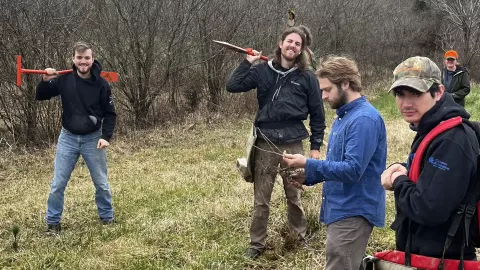
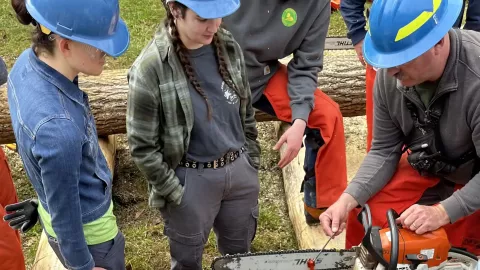
Week 8 - Spring Field Semester 2024
by Matt
Our instructors this week were Mr. Chad Niman and Dr. Jim Ringe. We started off by grading a chestnut oak, watching Mr. John Reinstetle demonstrate felling techniques with said chestnut oak, then grading it as a log once it was on the ground. The next day we sawed it into lumber and observed how tree and log grading translates to lumber quality. The graded lumber was taken to the Wood Utilization Center in Quicksand, KY on Wednesday where we stacked it and left it to dry for next year's class. While at the Wood Utilization Center, Mr. John Marcum helped us take red oak lumber and cut it to length, remove defects, and glue the table tops together. Thursday, we assembled our tables and cutting boards and made some cherry wood diplomas for the future graduates. The final day we lightly sanded our tables to prepare for the final finish to be applied and then finished our cutting boards by routing the edges, sanding them and finishing with mineral oil. This week was incredibly informative and truly demonstrated how a standing tree is turned into quality wood products. The entire process happened in front of our own eyes and was done with our own hands. It was an invaluable experience for future foresters to observe and take part in.
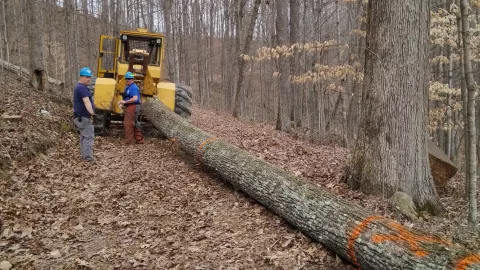
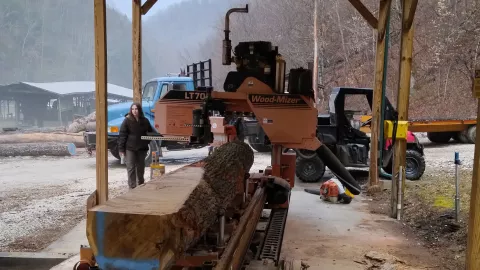


Week 7 - Spring Field Semester 2024
by Janson
This week, our forestry class, under the instruction of Dr. John Lhotka, applied silvicultural principles to sites within Robinson Forest. Silviculture is the science and art of managing a forest at the stand level to meet landowner objectives on a sustainable basis, utilizing methods such as tree harvesting, prescribed fire, crop tree release, and many others.
Because Robinson Forest is nearly 15,000 acres, we encountered a variety of different sites to manage. From pure pine stands to stands composed of mainly hardwoods like tulip poplar, maple, and oak, all on different positions of the mountain slopes, we had to take into consideration the varying soils, moisture levels, and sunlight exposure in order to properly manage for set objectives (such as long term regeneration of oak).
Our week consisted of exercises involving the use of various forestry instruments to take plots within forest stands in order to obtain data. We then used this data to draw conclusions about the state of the forest stand and write prescriptions to manage the stand. We simulated a crop-tree release, selecting certain trees (such as oak and pine species) within a stand to keep while marking competing trees for removal to aid the development of these desired trees. On Wednesday, we took a hike throughout Robinson Forest to see the diversity of sites within the forest. We ended the week with a leadership training course in Asbury, where we took part in a ropes course that ended in a zip-swing.
This week required us to think strategically about forestry practices that we have been learning throughout college and apply them at the ground level to meet objectives that we will encounter as professional foresters.
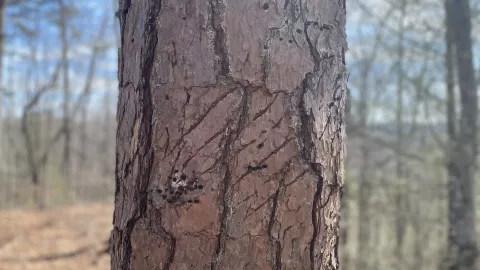
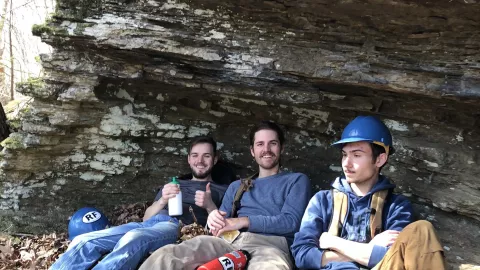

Week 6 - Spring Field Semester 2024
by Zachary
This was the first week we stayed at Robinson Forest. We had Dr. Jacob Muller for Forest Inventory and Measurements. We started the week familiarizing ourselves with the different forest sites in Robinson Forest. We spent the rest of the week working on our forest inventory skills and statistic analysis. We learned how to efficiently use our measurement tools and plan a timber cruise. The activities this week were helpful for us as forestry professionals because it is important that we know how to inventory a stand properly and how to interpret the data to make informed decisions.

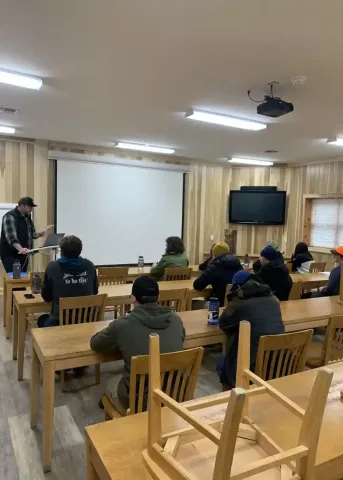
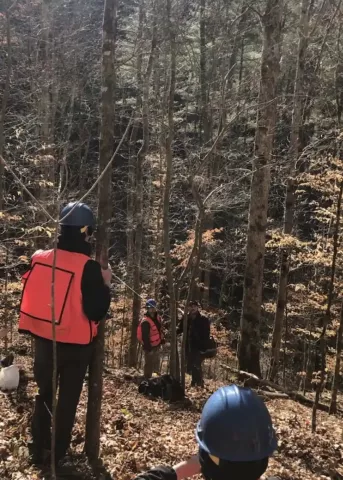
Week 5 - Spring Field Semester 2024
by Makaslyn
On Monday morning, Dr. John Lhotka reviewed the benefits of a midstory removal for encouraging oak regeneration at Berea College Forest for our Silvicultural Practices class. Then he sent us out in groups to practice using a prism to mark trees down to a target basal area for a shelterwood establishment cut. Prisms refract light, so near and big trees are more likely to look continuous than those that are far and small. These continuous ones are “in” trees, and we had to learn to make calls about which “in” trees to retain based on spacing, species, and form. This helped us understand how foresters combine measurements and intuition to construct new silvicultural situations. That afternoon, we took regeneration plots looking at woody interference and practicing identifying leafless seedlings.
On Tuesday we went to Raven Run Nature Sanctuary for our Project Learning Tree training where Doug McLaren and Jennifer Hubbard-Sanchez guided us toward becoming effective environmental educators. We were able to participate in learning activities geared toward 2nd graders and 8th graders, and then practiced educating our classmates. This was great for team building and helped us learn classroom management and leadership skills.
On Wednesday our Silvicultural Practices class went to the Daniel Boone National Forest where Forest Service Silviculturist Jake Royce took us to visit shelterwoods of different ages. This was useful to see what the treatment we marked on Monday could look like. That afternoon, we surveyed an artificial regeneration project, identifying which seedlings were planted and collecting data on their survival.
On Thursday we were back in Berea College Forest. topography maps to mark in a stand delineation exercise. As we hiked, Dr John Lhotka taught us how to tune our eye to important changes in the forest that can constitute a stand boundary, and we were provided with topography maps to practice delineating these stands ourselves. Since silviculture is practiced at the stand level, being able to delineate stands is one of the most foundational skills foresters can have. Then, they can manage forests in a way that is appropriate for what is there.
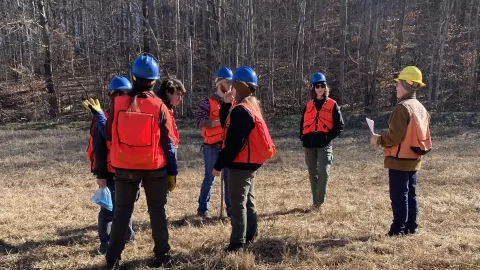
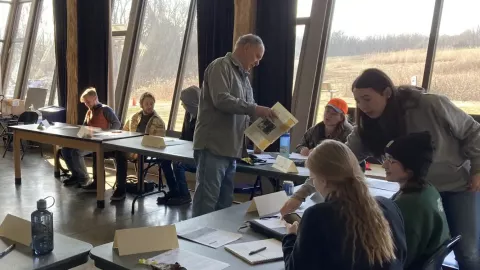
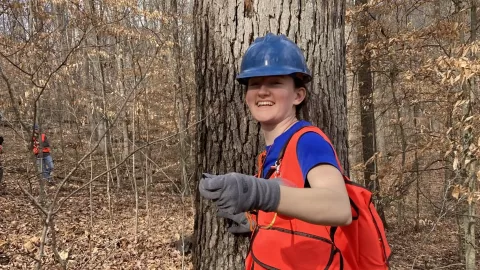
Week 4 - Spring Field Semester 2024
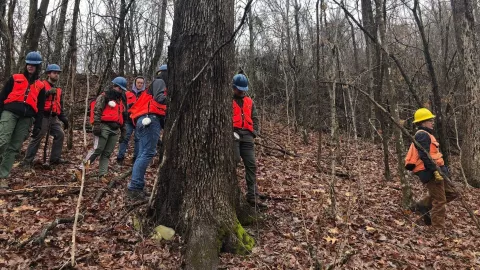
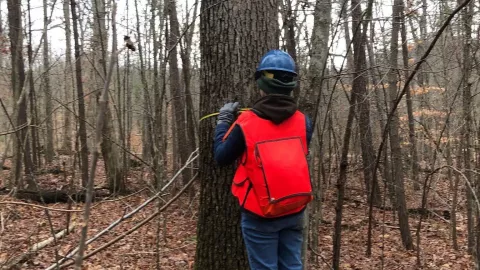
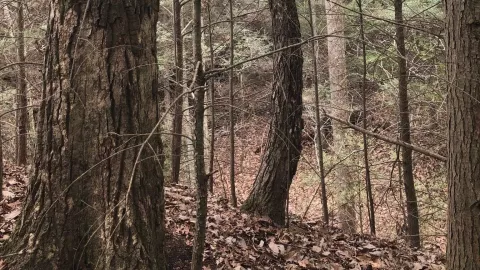
Week 3 - Spring Field Semester 2024
by Russ.
This week was our industry tour which included six companies around the city of Lexington. After two days of tours we attended the KTSAF meetings and participated in the yearly quiz bowl against University of Tennessee and Sewanee. Below is a summary of our industry tours.
The first stop on our tour was Harold White Lumber and Millworks in Morehead, Kentucky, established in 1968. Using Corley machinery, they process various wood species, producing around 12 million feet of lumber annually. The company efficiently utilizes sawdust for heating their dry kiln, minimalizing waste. Powell Valley Millwork/CMPC in Clay City specializes in poplar lumber, employing high-tech scanning for defect removal and generating approximately 400,000 feet per week. Freeman Corporation in Winchester faces challenges due to stave mills' impact and competition from plastic flooring alternatives.
Kentucky Hardwood Lumber Mill in Somerset, cutting over 10 million feet yearly with advanced machinery like an edger with detection capabilities. The associated Somerset Pellet Fuel Mill transforms sawdust into premium wood pellets, reducing waste. Somerset Hardwood Flooring focuses on red oak, white oak, and hickory. They efficiently manage lumber drying and utilize technology for precision cutting, staining, and sorting based on color and defects.
Commonalities among these companies include effective waste utilization, recognition of the need for land management skills.


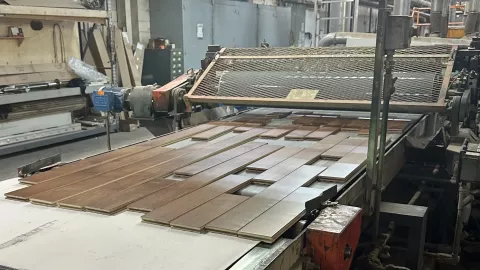
Week 2 – Spring Field Semester 2024
by Jasmine
The second week of the 2024 spring field semester was directed by Dr. Ellen Crocker in Lexington, Kentucky. The topics of forest pathology, mycology, and invasive plants were taught through the class Intro to Forest Health and Protection. All the activities this week were immensely important for a forestry student because cultivating and maintaining a sustainable forest should be a forester's goal.
Diseases were discussed in detail and explored through group projects. Each group chose an affliction to research and presented their findings at the end of the week. With mycology, we learned how to identify mushrooms and the different roles they play in the environment. Invasive plants and pests also covered identification as well as what we can do to manage these issues.
We had two guest speakers, Dr. Tyler Dreaden and Megan Buland. In the Garrigus building, Dr. Dreaden expanded on what we had learned that day about forest health and epidemics. Afterward, students utilized microscopes to observe fungi and bacteria in Petri dishes that were provided the previous week. Students had exposed them to different objects ranging from sinks and tools to energy drinks and earbuds. We then got the opportunity to take samples of the growths that had accumulated to examine and compare with classmates. With Megan Buland, we talked about how to cultivate mushrooms and her work with native orchids. With her help, we developed a take-home project to grow our own oyster mushrooms.
Dr. Crocker emphasized that forest health can mean different things depending on who you are talking to and the goals for the land. For the future of our careers, we need to be able to understand how to determine what constitutes forest health through the specific objectives of a landowner in conjunction with the needs of the ecosystem. Having a solid understanding of tree diseases, invasive plants, pests, and environmental indicators is necessary to make these determinations.

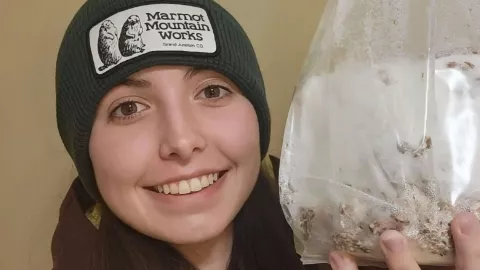
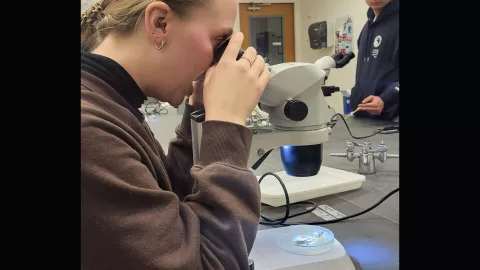
Week 1 - Spring Field Semester 2024
by Megan
The first week of the Spring semester, January 8th-January 12th, was spent as a general overview of the weeks to come and as a refresher for skills learned in previous semesters. The first day began with the professors of each course giving a brief description of what their class was to consist of during their designated week(s). Additionally, students were given all their equipment for the semester: a cruising vest, safety glasses, ear protection, a prism, a compass, and a logger’s tape. After lunch on the first day, students went to the Arboretum with Dr. Lhotka to practice measuring the height and diameter of trees with their new equipment. The first day truly sparked the excitement for the semester to come. Unfortunately, two days of the first week (January 9th and 12th) were cancelled due to bad weather. On these days, students would have completed a team-building rope course at Asbury University and practiced more skills at the Berea College Forest. On Wednesday the 10th, students remained at the Thomas Poe Cooper building to refresh their compass and mapping skills. The next day, students went to the Berea College Forest with Dr. Lhotka to put their skills to the test in some compass and mapping exercises. The day spent in Berea helped a lot of the students refresh their skills and get a taste of how exciting the rest of the semester would be, as one of the exercises basically put you in the middle of the forest, and the challenge was to find your way back! Being in the forest also gave a lot of students some perspective on how a plot cruising would be in a real scenario.

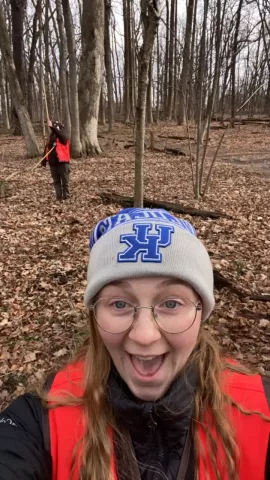

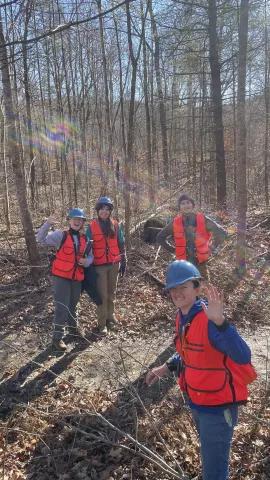
Questions?
For questions or additional information on the undergraduate forestry program, contact Laura Lhotka, Forestry Academic Coordinator at 859-257-8718 or laura.lhotka@uky.edu. Also, email Laura if you would like to arrange an in-person visit or a Zoom meeting. Let us know how we can help!
Email Laura Lhotka